A-90 Orlyonok
Landing tanks on a beach at 400 kph: The A-90 Orlyonok series are the only crafts of any type worldwide capable of landing a full Marine batallion on any beach, complete with armored vehicles and heavy equipment, after crossing 1500 km at 400 kph. This miracle had been done back in the cold war by USSR, until these amazing crafts were inherited by the Russian Navy.
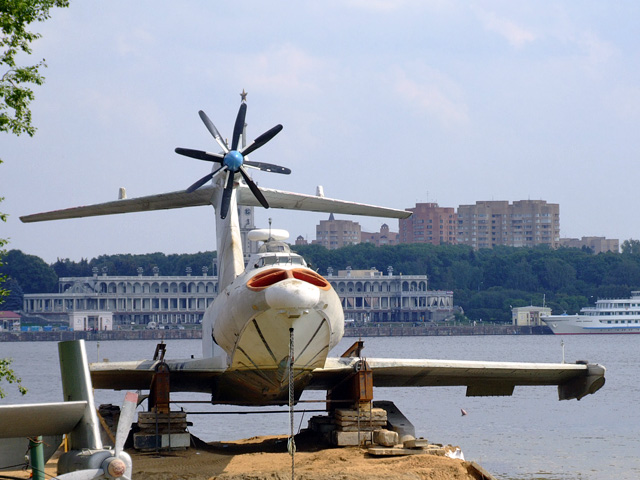 Preserved A-90 at the Central Hydrofoil Design Bureau, before it was transferred to Moskow
Preserved A-90 at the Central Hydrofoil Design Bureau, before it was transferred to Moskow
These are the only crafts capable to do that. Strategic carrier aircrafts of sufficient size are bound to airports and tactical ones to prepared landing strips, while all are vulnerable to AA and SAM fire. Very large Hovercrafts like the Russian Zubr class could also land a range of APCs, IFVs, and even MBTs (Main battle tanks), but at 55 knots sustained (120 kph) over 560 km. They still are targets for missiles. So the Ekranoplanes are a unique option offered solely to Russian Marines for quick response amphibious warfare. But these machines procedeed from a long lineage with associated engineers suh as Bartini and Alexeyev.
https://youtu.be/UzH0xfl3inM
Soviet Archives Film
The Ekranoplane miracle
The very name “ekranoplane” is Russian. In the Anglo-Saxon and western world at large, these extraordinary machines are generally known as wing-in-ground effect vehicles, and they never really passed the experimental stage.
This expertise is truly a Russian one now, and the former complex responsible for the Soviet Ekranoplane program is trying to revive these crafts to the world market, with some advantages: neither really planes or ships, hydropters or hovercrafts, these fantastic contraptions escape all classifications and offer very real advantages over water.
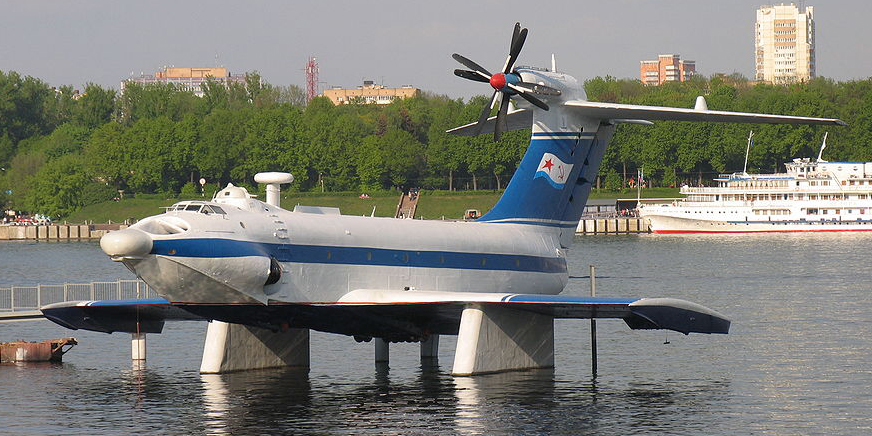 Orlyonok at the Museum of the Navy, Moscow
Orlyonok at the Museum of the Navy, Moscow
They are faster than anything that floats, since they only touch water at the start and in the end, and are much more economical than planes, although their speed and range is smaller. Potentially, as shown by the humongous Ekranoplane KM (or “Caspian monster”), such crafts can be well over 100 m long and in excess of 500 tons with payload to match.
No doubt they made salivating the chiefs of staff of the Soviet Navy, always searching for innovative ways to deal with a much superior (but more conservative or less disruptive) US Navy. The first and gigantic Ekranoplane KM (“known as Caspian monster” by NATO) led to devise two series of crafts, the Lun, for anti-ship warfare, and the Orlyonok, for the Soviet Marines.
Both looks superficially like flying boats, that is before seeing their stubby and thick wings and the placement of their jets or props. Today however, the very costly program has been long mothballed following the decomposition of USSR back in the 1990s. Outside three prototypes, only three were ever active in the 1980s. The A-90 entered military service indeed in 1979. Units S-21, S-25 and S-26 remained in active service at least until 1993. There is no replacement in sight or project to have them operational again (see later).
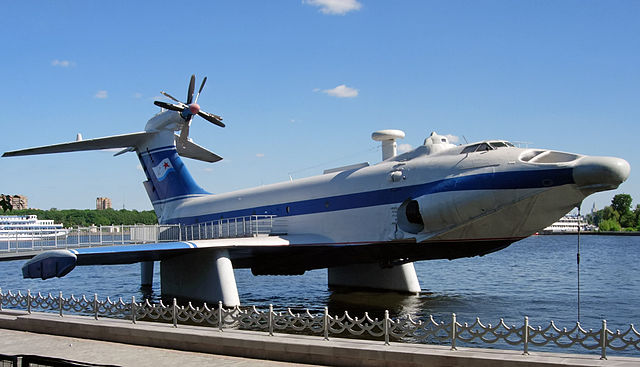 Preserved Orlyonok at at the Museum of the Navy, Moscow
Preserved Orlyonok at at the Museum of the Navy, Moscow
From Mustard channel, the Caspian monster and Ekranoplane concept
The base principle
In short, WIGs use a cushion effect under very large wings ended by downwards-curved ends to trap the air, while some additional pressure air is injected by using turboprops or jets for the crucial lifting. This ground-in-wing effect (WIG) helps creating a cushion of air which is mobile, and not captive as for the Hovercrafts and create a sustentation effect alowing much greater speeds. There is no contact at all also contrary to the Hydropters. This aerodynamic interaction between the wings and the surface led to many denominations, such as flarecraft, sea skimmer, or wing-in-surface-effect ship (WISE).
Lineage of the program
Documentary about the lineage and history of Ekranoplanes
The whole story of this kind of sustentation system was thought in the pioneer era, in the 1910s already, called the lift-dependent drag. These works implying a simple principle: The more a wing is closed to the ground, the more it became efficient for sustentation. The simple fact that air molecules are closer together below the wing, they form a warmer cushion of air which multiplies the wing efficiency. The backdrop of this system is that massive limits the speed such vehicle can achieve. Basically in this system, speed is traded for lifting capabilities. In a normal wing, reducing drag calls for a higher aspect ratio of the wing: The longer and skinnier they are the better. The best example are gliders and high altitude crafts such as the Lockheed U2. When reversing the principle, this underneath high pressure can be turned into an advantage at very low altitude.
WIGs are often seen as a transition between a hovercraft and an aircraft, since they are unable to use this wing-in-ground effect below a certain speed. So at the start and arrival, thay act like normal plane when taking off and landing. Contrary to the hovercraft that can keep its own trapped cushion of air to travel on land as a real amphibian, the Ekranoplane cannot.
Early contenders: The Austro-Hungarian glider boat oddity
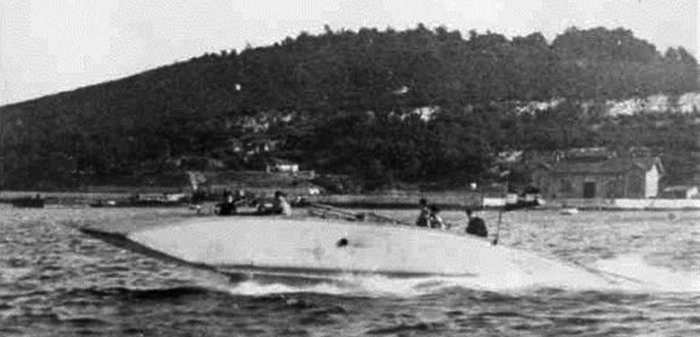 The KuK Versuchgleitboot or “glider boat” ws a mix between a WiG and hovercraft back in 1916.
The KuK Versuchgleitboot or “glider boat” ws a mix between a WiG and hovercraft back in 1916.
One of the earliest military example of such vehicle was the very innovative Austro-hungarian Versuchsgleitboot, an attempt to devise a “gliding boat”. It was not really a hovercraft since no air was trapped underneath, more of an Ekranoplane. The end goal was to devise blazing fast motor torpedo boats to sink allied battleships and cruisers, and restore balance in the Adriatic. It remained however a prototype build in 1916 by Dagobert Müller von Thomamuehl. Using however the feeble engines of the time it could only reach 32,6 knots top speed. This was however way above anything that floats then for a military boat.
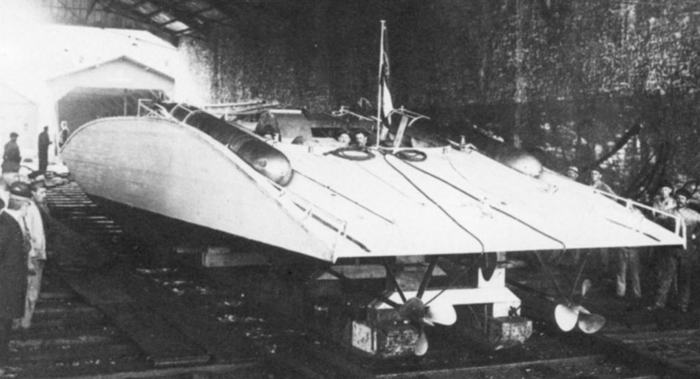 The Versuchsgleitboot used side skirts which only partially trapped air – it was still capable to flow freely between the two ends of the wing, and the air cushion was located towards the front and capable of lifting the rear section of the boat up to 10 inches off the surface and the whole hull was completely off the water surface passed 20 knots. But it was unstable, dangerous in high seas, too wobbly to launch torpedoes with precision or depth charges, so after testings the board did not recommended its use and suggested to concentrate on torpedo planes instead.
The Versuchsgleitboot used side skirts which only partially trapped air – it was still capable to flow freely between the two ends of the wing, and the air cushion was located towards the front and capable of lifting the rear section of the boat up to 10 inches off the surface and the whole hull was completely off the water surface passed 20 knots. But it was unstable, dangerous in high seas, too wobbly to launch torpedoes with precision or depth charges, so after testings the board did not recommended its use and suggested to concentrate on torpedo planes instead.
In fact, pilots were already well aware of this ground effect phenomenon as they could feel it by themselves when landing. Some aircraft created such sustentation that they even “refused to land”. But this was true because back then the engines were weak and the whole structure very light. One French author Maurice Le Sueur, even expressed the idea of using ground interference permanently as a way of locomotion. Over the ground it was nearly impossible but over water, that was another story, so early experiments focused on that area. It took time to mature this technology , in fact, decades, up to 1960, when on both sides of the cold war checker, Rostislav Alexeyev for the Soviet Union and Alexander Lippisch, for United States started work on this concept.
 Lippisch Rhein-Flugzeugbau X114, later incorporated in the short-lived Hanno Fischer’s Flugmechanik’s personal crafts.
Lippisch Rhein-Flugzeugbau X114, later incorporated in the short-lived Hanno Fischer’s Flugmechanik’s personal crafts.
Lippisch is familiar to all that learned about the first rocket-propelled jet, the WW2 Messerschmitt 163 Komet. But Lippisch, a glider specialist, became known for his work on tailless aircrafts and many other aspects of flight. He eventually settled in the USA. On the other hand, R. Alekseyev worked from his background as a ship designer, teaming with aeronautical engineer Robert Ludvigovich Bartini to produce amazing crafts and carry the concept to operational level for the Soviet Navy.
Bartini’s prototypes
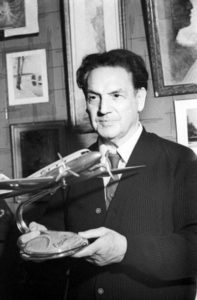 A nobleman in descent, Roberto Bartini was born in Fiume, Austria-Hungary. His relatives were impoverished aristocrats so he was raised by a peasant family. He fought on the eastern front in 1916 but was later captured by Russian troops, interred at a POW camp in near Khabarovsk in the Russian Far East. Later released he took the Italian nationality. He soon joined the Italian communist party and began studying aerospace at the Politecnico di Milano in 1922. However after the Fascist takeover he accepted to move at the demand of his party to USSR, to learn and work as an aviation engineer. He also took with him all the latest Italian design and avant-garde technology he knew about. He also changed his name to a more slavic Robert Ludvigovich Bartini.
A nobleman in descent, Roberto Bartini was born in Fiume, Austria-Hungary. His relatives were impoverished aristocrats so he was raised by a peasant family. He fought on the eastern front in 1916 but was later captured by Russian troops, interred at a POW camp in near Khabarovsk in the Russian Far East. Later released he took the Italian nationality. He soon joined the Italian communist party and began studying aerospace at the Politecnico di Milano in 1922. However after the Fascist takeover he accepted to move at the demand of his party to USSR, to learn and work as an aviation engineer. He also took with him all the latest Italian design and avant-garde technology he knew about. He also changed his name to a more slavic Robert Ludvigovich Bartini.
He worked at the Central Design Bureau of Sevastopol, with the research wing of the Red Army, his Stal planes series breaking records in the 1930s. He was however arrested in the great purges in 1938 over false charges as “enemy of the people” by the NKVD. Condemned for 10 years, his skills however were too precious for the Gulag and he was allowed to continue his work on other projects. He worked for Tupolev and designed the Tupolev Tu-2, and his own-short-lived Yermolayev Yer-2 during the war. Released in 1946 he worked with the Dimitrov Aircraft Factory in Taganrog until 1952, Scientific Research Institute in Novosibirsk, and after being rehabilitated under Kruchtchev, with the OKBS MAP design bureau in Lyubertsy. He also desiged a nuclear-propelled bomber, but developed soon a keen interest in ground effect vehicles
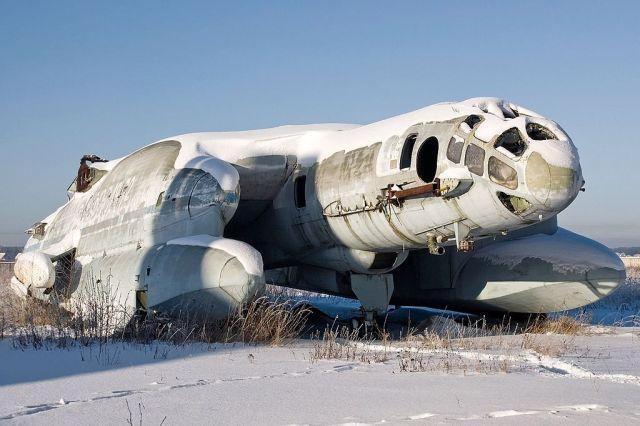 Bartini-Beriev VVA-14, nowadays. A known youtube catching picture.
Bartini-Beriev VVA-14, nowadays. A known youtube catching picture.
In 1964 he created the Be-1 prototype ekranoplan with Beriev. It was only used by Beriev’s own test department. In 1968, Bartini returned to Taganrog to develop seaplanes, while starting his own late project, the Bartini Beriev VVA-14 (photo). This was his last tested craft, since the next one stayed on paper, as an experimental ekranoplan capable of vertical takeoff for ASW warfare. Bartini was nicknamed “Barone Rosso” (Red Baron), being a staunch communist and of aristocratic descent, which was uncommon.

Rostislav Alexeyev’s ekranoplanes
 Born December 18, 1916, in Novozybkov (Chernigov), and later moving to Gorky, by 1935 trained in shipbuilding at the local Industrial Institute, Alexeyev graduated in October 1941 on a thesis on hydrofoils. He worked as a naval engineer at Red Sormovo shipbuilding factory, which manufactured tanks instead than ships during the war. By 1942, he was tasked by the Soviet Navy to develop armed hydrofoils. By the end of the war none, of his designs were ready but the Navy maintained interest and ordered 340 hydrofoil to be built nevertheless by the late 1940s. Alekseyev was the chief designer of the Raketa, first passenger hydrofoil in 1957. He was to design many other passenger hydrofoils at Red Sormovo, like the Meteor, Kometa, Sputnik, Burevestnik, and Sunrise.
Born December 18, 1916, in Novozybkov (Chernigov), and later moving to Gorky, by 1935 trained in shipbuilding at the local Industrial Institute, Alexeyev graduated in October 1941 on a thesis on hydrofoils. He worked as a naval engineer at Red Sormovo shipbuilding factory, which manufactured tanks instead than ships during the war. By 1942, he was tasked by the Soviet Navy to develop armed hydrofoils. By the end of the war none, of his designs were ready but the Navy maintained interest and ordered 340 hydrofoil to be built nevertheless by the late 1940s. Alekseyev was the chief designer of the Raketa, first passenger hydrofoil in 1957. He was to design many other passenger hydrofoils at Red Sormovo, like the Meteor, Kometa, Sputnik, Burevestnik, and Sunrise.
However by 1962, Alexeyev started work at the Central Hydrofoil Design Bureau which concentrated on secret military ground effect vehicles, the famous ekranoplanes. Soviet authorities backed the project with considerable fundings and enthusiasm as it was seen as a groundbreaking innovation, unknown from the rest of the world, to balance the domination of the West. Due to their low altitude of a few meters, these crafts were classified as ships by the Soviet government (and that’s why they are treated here in naval encyclopedia !). Alexeyev participated in the development of a very large prototype of a WiG thanks to his expertise with hydrofoils. 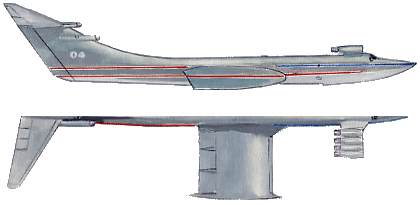
Author’s rendition of the Ekranoplane KM
The Korabl Maket (KM) made its appearance on the Caspian sea for testings. NATO spy planes which soon catch it left western intelligence experts baffled. Soon known in the West as “Caspian Sea Monster”, Alexeyev soon became the chief designer, assisted by V. Efimov as lead engineer. The gigantic KM, largest flying crafts ever built at that point, was completed in 1966, powered by eight Dobrynin VD-7 turbojet engines on the front of the fuselage, and two on the tail for takeoff. 
The Ekranoplane KM was built by Gorkiy’s Red Sormovo factory and secretly passed along the Volga down to Kaspiysk in the Caspian Sea. There, the area became the Soviet “aera 51”, with the best prototype operated by elite test pilots of the Soviet Air Force. The KM made its debuts on October 16, 1966, co-piloted by Alexeyev himself, a usual practice of the time. This prototype was seen as a very promising and was though after by the military for many purposes. However the design had many flaws and progress slowed down to such a pace that this model became a known “white elephant” until it was terminated.
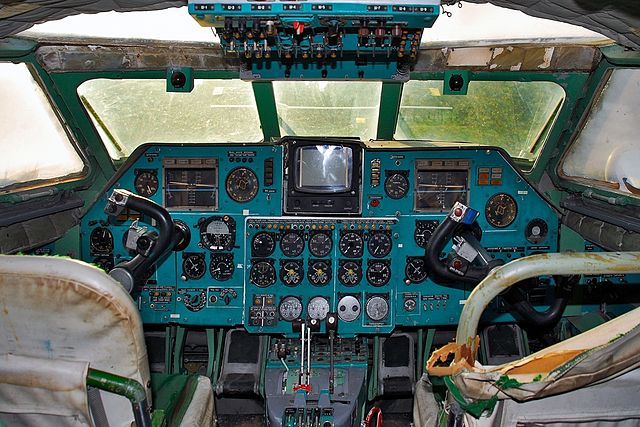
Orlyonok’s cockpit
Alexeyev soon moved on other ekranoplan projects, his most successful design being the A-90 Orlyonok (maiden flight 1972), entering service in 1979 as an amphibious carrier for the Soviet Marines. Next, Alexseyev also worked on a massive model, dedicated to anti-ship warfare as a second use proposal by the Navy. Called “Lun” this Ekranoplane was even more massive, jet-propelled, and armed with a panoply of six large antiship “Moskit” missiles In theory undetectable by radars, it served for evaluation by the Soviet, and later Russian navy. But that’s for another day.
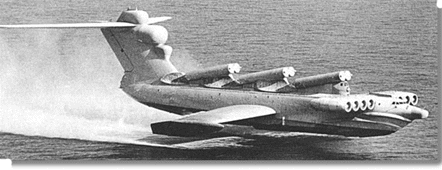
Genesis of the A90 Orlyonok
The smallest of all three military Ekranoplane types built by USSR, the A-90 Orlyonok (“eaglet”) was also the only one to be operational with a small serie production.
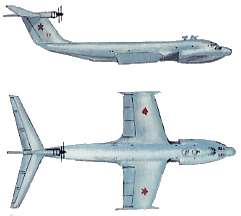
1/750 rendition of the Orlyonok
The idea of creating a fast military transport capable of carrying a large payload was tempting, but authorities were not focused solely on the Ekranoplane: Hydropters and hovercrafts were also considered. Therefore the Central Hydrofoil Design Bureau was working on this top secret project, which basically ended at the fall of the Soviet Union.
Development
Chief Designer R.E. Alexeyev, was well regarded in higher spheres for its energy and passion for the project. He has designed several prototypes already in the 1960s, which all worked well and was soon at the head of the technical teams. In 1971 Alexeyev developed a medium-sized Ekranoplan tailored as a military transport. This project was known first through its military designation Objekt 904 “Orlan” or “Orlyonok” (little eagle or eaglet). The S-20 “Dubl” completed in 1972 according to Conways, could have been the original “Caspian monster”. Conways also states the next S-23 was completed in 1975. It was perhaps after rebuilding and second commission.
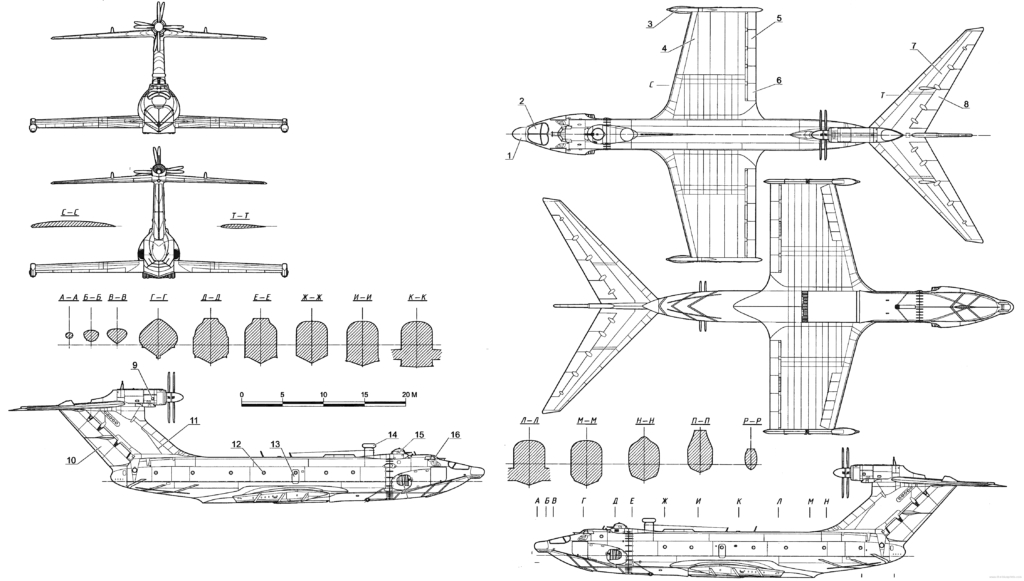 Full blueprint of the A-90 (from the-blueprints.com, unknown origin)
Full blueprint of the A-90 (from the-blueprints.com, unknown origin)
The S-23 was the first to fly and being tested on the Volga River in the autumn of 1972. The next year it was dismantled and carried in section to the Caspian Sea. Reassembled, the S-23 resumed testings this time on a far larger area. However in 1975 the S-23 crashed, but apparently (according to Russian sources), the pilot was able to recover, restart his craft and return to the base. The enquity later proved there was a deficiency in the alloy used for the hull. This was fixed for all subsequent models, S-21 (1978*), S-25 (1979*), S-26 (1980*).
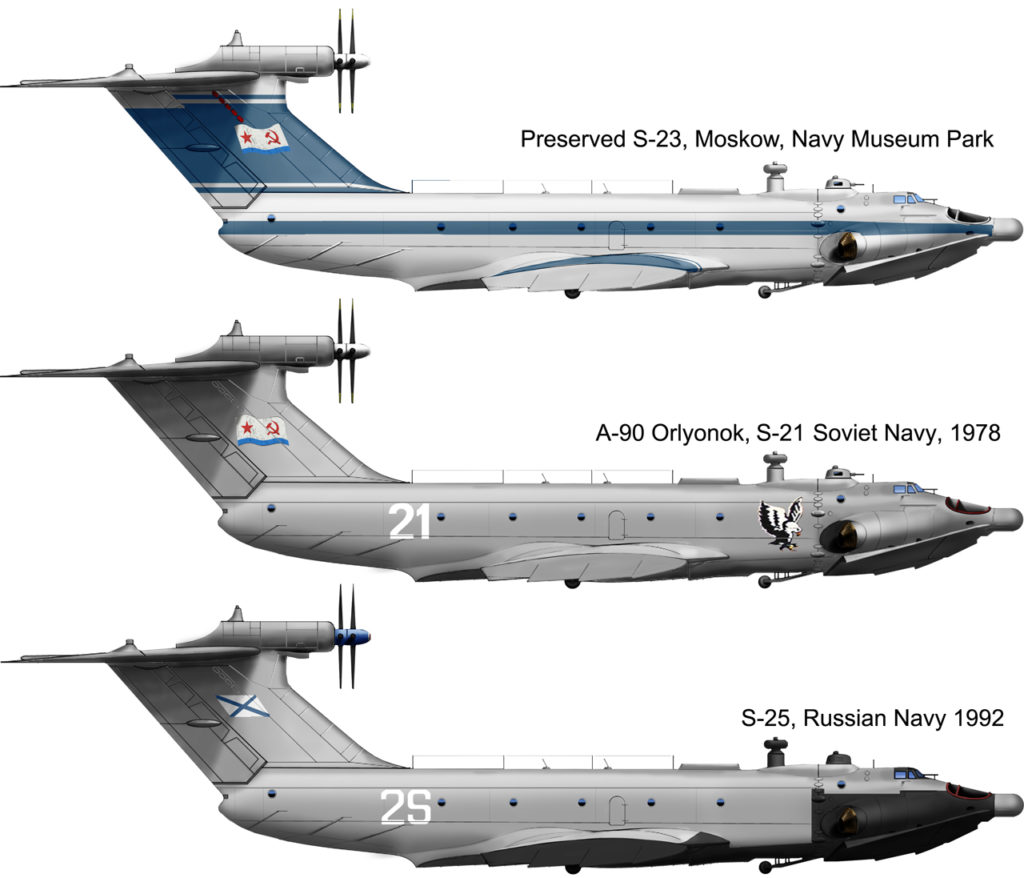
Author’s HD Illustration, variants of the Orlyonok
Design of the Orlyonok/Orlan
The Orlyonok was an Ekranoplane of relatively small size compared to the two other military types developed by USSR at that time. The KM was the largest of all, while the A-90 was half its weight in battle order. The Orlyonok was designed as a transport and beach assault vehicle from the start. Therefore it was amphibious and equipped with wheels for beaching and takeoff from land, after embarking AFVs and Marines.
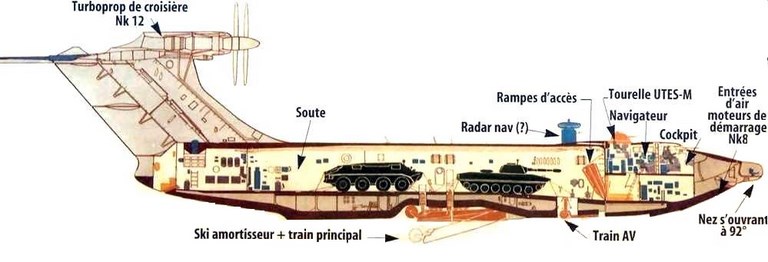 Cutout of the Orlyonok, author unkown, from le Curionaute.fr
Cutout of the Orlyonok, author unkown, from le Curionaute.fr
Propulsion and operating mode
The Orlyonok engine layout was unusual compared to the others. For range, it was not equipped with a battery of jets, but with a single turborpopeller, placed on top of the tail. This was a massive Kuznetsov NK-12, the most powerful of this type ever designed (rated for 11,000 Kw, with contrarotative props), the same that propelled the “Russian B-52”, the Tupolev Tu-95 “Bear” also used by the Navy. But as the latter had four, the Orlyonok single one was sufficient to provide the cruise speed and some lift when taking off.
In the nose, in complement, were mounted two conspicuous turbofan engines with their intakes protruding on top while their exhausts were located along the lower sides of the fuselage. They benefited from vectoring thrust and blow under the wings, increasing lift and providing extra propulsion for takeoff. When the speed was sufficient for a stabilized WiG, these front engines were shut off. This was also for safety, reducing the chances of taking in water, salt low flying birds among other on the way.
Takeoff and landing were assisted also by large flaps greatly increasing lift and capturing if needed PAR thrust (vectorial thrust), increasing increased air pressure on difficult terrains like mud and sand. When landing on water, an heavy-duty hydro-ski was deployed an dextended out of the belly, located below the main wings.
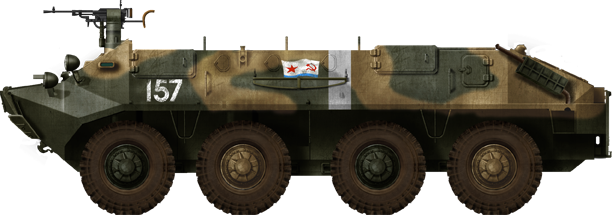
A BTR-60P of the Soviet Marines in the 1970s (author’s illustration for tanks-encyclopedia.com)
Payload:
Most importantly for embarking and landing troops and hardware, the engineers choosed to hinge the Orlyonok’s nose, just behind the radome. The whole front part opened sideways in seconds, allowing fast disembarkation of the troops and Armoured fighting vehicles. These were likely to be of the BTR-60, BTR-70 or BTR-80 type. To facilitate the vehicules exit or loading the craft’s bay, the A-90 was given a built-in folding ramp, requiring therefore no external support. According to the above cutout picture (from “le curionaute”), perhaps with translated legends after a soviet book, the bay seems large enough to carry a BTR-60 and a PT-76. Both were amphibious vehicles and the lenght of the bay would allowed in that case to carry either three BTRs or three PT-76s.
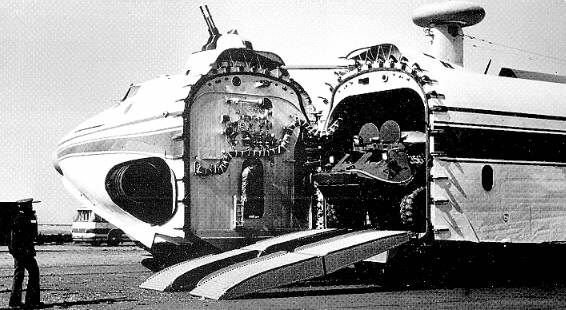
Orlan’s open bay, with the nose hinged sideways, onboard extending ramp in place. The vehicle is likely to be a marines BTR-60. The NSVT-armed turret could bring some close support when landing.
The BTR-60 is 2.83 m wide and the PT-76 is 3.14 m wide, giving an indication of the width tolerance of the bay. Other scenarios includes up to 200 men, or just the ones that takes place in the two BTRs and a complement, or for supplies a total of 28 tons of cargo. If it’s the case, three PT-76s amphibious tanks (45 tons total) is unlikely indeed. Heavier tanks like those of the T-54/55, 62 or 72 seems out of question either.
Armament: The Orlyonok being a military craft, the type of armament carried was purposedly intended to deal with ground and airborne threats when beached or en route. The turret installed after the cockpit, before the radome is fitted with a twin NSVT mount. These heavy machine guns introduced from 1971 gradually replaced the KPVT, a soviet replica to the Western standard M1920 browning cal.50. They can fire 12.7×108 mm rounds at 700-800 rpm, at 845 m/sec muzzle velocity, hitting ground targets up to 2000 m away or helicopters in a range of 1500 m.
Production, service and further development
“Five” units were built, the only “serie” for these crafts compared to the sole Lun and KM. And the first was a non-flying testbed demonstrator which was scrapped. In fact one was non-flying and one was rebuilt, bringing the real total down to three operational.
The first experimental craft of the orlyonok class was the S-23, which crashed in 1975, later retreived and completely rebuilt as S-23. Next there were the to others “pre-production” models:
- S-23 was the rebuikt S-21, completed in 1978, lost during an accident in 1992
- S-25 completed in 1979
- S-26 completed in 1980
The A-90 class entered service in 1979 and the three units above remained active until at least 1993. Budget constraints will prove their undoing. However nowadays with a financial situation slightly better, there are still plans to resume production of the Orlyonok. Previously it would have been built in Petrozavodsk.
Post cold-war prospectives
In the early 1990s, a reconversion was also on the starting blocks, and several variants were planned, with some modifications actively carried out:
A.90.150 arctic survey craft:
This was a scientific modification of the of the orlyonok as MAGE (marine Arctic geological survey ekranoplan). Its propeller had a reduced span, small stroke while the nose vector exhausts were driven by a diesel engine for more range. The opening flaps are redesigned and a new equipment is carried onboard: Bottom soil sampling system, seismic measurements, magnetometric and gravimetric reconnaissance.
Maritime rescue version:
Developmed alongside the Antonov ANTK, this project of airborne maritime rescue system was created in reaction to a recent drama at sea when a Russian submarine of the November class sank was no rescue ships could arrive in time to save the surviivng crew. The orlyonok could have been deployed in the matter of hours on site. For this task, it was mounted on top of the An-225. The Orlyonok was modified with extended range and rescue equipments including a clinic with folding beds, pumps and welding equipments to attack the hull, etc. The great advantages of craft was to be carried at 700 kph on the spot, than launched on strong waves, destructive for seaplanes. The cruising range allowed to operate on any world’s oceans and polar regions as well as the orlyonok can operate on ice.
Technical Specifications
Dimensions: Length 58.10 m, wing span is 31.50 m, height is 16.30 m, wing area 600,00 m2.
Empty weight: 100 tons, maximum take-off weight 140 tons.
Propulsion: 2 x NK-8-4K thrust-vectoring in the nose; 1 х НК-12МК turboprop; 1x APU TA-6A.
Thrust: Nose, 2 x 10,500 kgf, traction: 13 465 liters.
Top speed: 400 km/h, cruising speed 360 km/h, practical range 1500 km, cruise alt. 2-10 m.
Seaworthiness: Up to Force 5.
Crew: 6-9 (not counting troops).
Payload: 200 infantrymen or 28,000 kg cargo or 1-2 APCs.
Armament: 2 × 12.7 mm in a dome turret with NSVT heavy machine guns.
Equipments: МР-244 “Screen” nav system and “Splav” radar.
Read More/Links/Src
- A-90_Orlyonok (wiki)
- Conway’s all the world’s fighting ships 1947-1955
- New Ekranoplanes – theregister.co.uk
- On disciplesofflight.com
- wikimedia commons photos of the A-90_Orlyonok
- Modern ekranoplanes on flightglobal.com
- AirFish-8 (video)
- thedrive.com Russian talks about bringing back military Ekranoplanes for service in the Arctic
- The 1950s US Aerofoil Boat X-112 (video)
- Russian Aqualines ekranoplanes
- The orlyonok on forum.ysfhq.com
- List_of_ground_effect_vehicles (wiki)
- Caspian_Sea_Monster (wiki)
- Ground-effect_vehicle (wiki)


 Latest Facebook Entry -
Latest Facebook Entry -  X(Tweeter) Naval Encyclopedia's deck archive
X(Tweeter) Naval Encyclopedia's deck archive Instagram (@navalencyc)
Instagram (@navalencyc)





 French Navy
French Navy Royal Navy
Royal Navy Russian Navy
Russian Navy Armada Espanola
Armada Espanola Austrian Navy
Austrian Navy K.u.K. Kriegsmarine
K.u.K. Kriegsmarine Dansk Marine
Dansk Marine Nautiko Hellenon
Nautiko Hellenon Koninklije Marine 1870
Koninklije Marine 1870 Marinha do Brasil
Marinha do Brasil Osmanlı Donanması
Osmanlı Donanması Marina Do Peru
Marina Do Peru Marinha do Portugal
Marinha do Portugal Regia Marina 1870
Regia Marina 1870 Nihhon Kaigun 1870
Nihhon Kaigun 1870 Preußische Marine 1870
Preußische Marine 1870 Russkiy Flot 1870
Russkiy Flot 1870 Svenska marinen
Svenska marinen Søværnet
Søværnet Union Navy
Union Navy Confederate Navy
Confederate Navy Armada de Argentina
Armada de Argentina Imperial Chinese Navy
Imperial Chinese Navy Marinha do Portugal
Marinha do Portugal Mexico
Mexico Kaiserliche Marine
Kaiserliche Marine 1898 US Navy
1898 US Navy Sovietskiy Flot
Sovietskiy Flot Royal Canadian Navy
Royal Canadian Navy Royal Australian Navy
Royal Australian Navy RNZN Fleet
RNZN Fleet Chinese Navy 1937
Chinese Navy 1937 Kriegsmarine
Kriegsmarine Chilean Navy
Chilean Navy Danish Navy
Danish Navy Finnish Navy
Finnish Navy Hellenic Navy
Hellenic Navy Polish Navy
Polish Navy Romanian Navy
Romanian Navy Turkish Navy
Turkish Navy Royal Yugoslav Navy
Royal Yugoslav Navy Royal Thai Navy
Royal Thai Navy Minor Navies
Minor Navies Albania
Albania Austria
Austria Belgium
Belgium Columbia
Columbia Costa Rica
Costa Rica Cuba
Cuba Czechoslovakia
Czechoslovakia Dominican Republic
Dominican Republic Haiti
Haiti Hungary
Hungary Honduras
Honduras Estonia
Estonia Iceland
Iceland Eire
Eire Equador
Equador Iran
Iran Iraq
Iraq Latvia
Latvia Liberia
Liberia Lithuania
Lithuania Mandchukuo
Mandchukuo Morocco
Morocco Nicaragua
Nicaragua Persia
Persia San Salvador
San Salvador Sarawak
Sarawak Uruguay
Uruguay Venezuela
Venezuela Zanzibar
Zanzibar Warsaw Pact Navies
Warsaw Pact Navies Bulgaria
Bulgaria Hungary
Hungary

 Bundesmarine
Bundesmarine Dutch Navy
Dutch Navy Hellenic Navy
Hellenic Navy Marina Militare
Marina Militare Yugoslav Navy
Yugoslav Navy Chinese Navy
Chinese Navy Indian Navy
Indian Navy Indonesian Navy
Indonesian Navy JMSDF
JMSDF North Korean Navy
North Korean Navy Pakistani Navy
Pakistani Navy Philippines Navy
Philippines Navy ROKN
ROKN Rep. of Singapore Navy
Rep. of Singapore Navy Taiwanese Navy
Taiwanese Navy IDF Navy
IDF Navy Saudi Navy
Saudi Navy Royal New Zealand Navy
Royal New Zealand Navy Egyptian Navy
Egyptian Navy South African Navy
South African Navy






























 Ukrainian Navy
Ukrainian Navy dbodesign
dbodesign